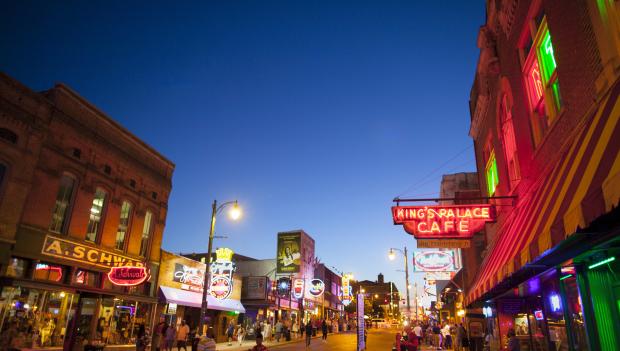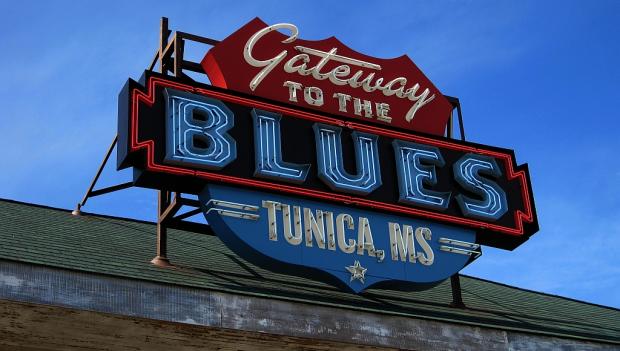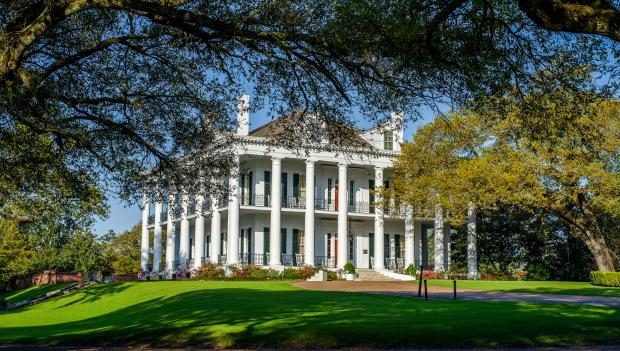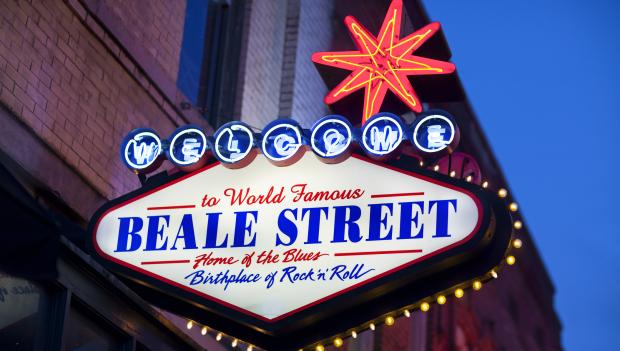
The Blues were born in the late 19th Century, evolving in the early 20th Century in New Orleans, Memphis, and throughout the Mississippi River Delta. Blues lovers, history buffs, and anybody yearning to experience the Deep South and its rich musical and cultural traditions, are well advised to take a Blues Road Trip. Our itinerary below details a Blues Road Trip taking you on a camping road trip along the Blues Highway, through the Mississippi River Delta, from Memphis to New Orleans.
Recommended: 9 Great Campgrounds for Spring Break in the South
Day 1: Memphis
Home of the Blues:
Although the blues had been around for decades in the Mississippi River Delta, it wasn’t until about 1910, when the blues came to Memphis, that the music gained popularity with a larger audience. The rural blues sensibilities mixed with urban upbeat rhythms created a new blues sound. Many blues artists began moving from the Delta north to Memphis, congregating at Beale Street, the epicenter of the Memphis blues scene. Beale Street remains a draw for blues and other musical artists to this day, and Memphis is known as “The Home of the Blues.”
What to do in Memphis:
1. Check out the Hall of Fame Blues Museum
2. Listen to live Memphis blues at any number blues bars on Beale Street
Where to Stay: Cook’s Lake RV Resort and Campground
A hidden gem only 10 minutes from Beale Street, the park is a convenient location that also offers a peaceful camp setting beside a lake in a gated property.
Day 2: Memphis to the Mississippi River Delta
Drive Time: 2 hours total (Memphis to John Kyle State Park through Tunica)
The Gateway to the Blues:
As you head south, we recommend a stop off in Tunica. This town marks the entrance to the Mississippi River Delta and is home to the Gateway to the Blues Museum. The facade of the museum is constructed from a rural train depot that was built about 1895. Inside you can immerse yourself in visually, and of course, sonically gorgeous blues exhibits. The town also has its share of blues festivals.
What to do in Tunica:
1. Hit up The Gateway to the Blues Museum
2. Go to one of the many blues bars, or a blues festival like Blues on the River in early June.
Where to Stay: John Kyle State Park
Located on scenic Sardis Reservoir, John W. Kyle State Park is beloved for its natural beauty characteristic of the Mississippi River Delta Region.
Day 3: Visit Clarksdale
Stay another night at John Kyle State Park and take a day trip to the birthplace of the Blues.
Day Trip Drive Time: 1 hour to/from John Kyle State Park
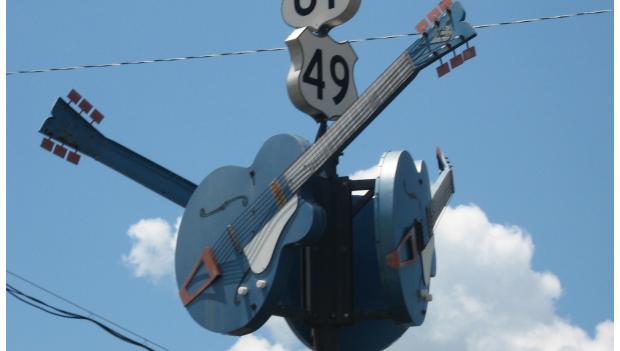
The Birthplace of the Blues:
As Memphis is known as the “Home of the Blues,” Clarksdale is nicknamed “The Birthplace of the Blues.” Although a small town, Clarksdale has produced some of the most renowned blues musicians, including John Lee Hooker, Big Jack Johnson, Earl Hooker, Ike Turner, and Sam Cooke.
In the center of town is the Crossroads, at the intersection of Highway 49 and 61 (the “Blues Highway”). This junction has inspired many a blues song, including the legendary Crossroads Blues, whereby Robert Johnson tells the tale of selling his soul to the devil to gain legendary bluesman status.
Another point of interest is the Riverside Hotel. Originally a hospital for African Americans, the building became a lodge for famous traveling blues artists and is the place where blues legend Bessie Smith passed following a car accident. And as can be expected in the birthplace of the blues, live blues music can be heard at virtually any hour in a Clarksdale joint, bar or public venue.
What to do on your day trip:
1. Stop off at the Crossroads
2. Head into the Delta Blues Museum
3. Check out the site of Muddy Waters’ cabin
4. Visit the Riverside Hotel
5. Listen to live blues
Recommended: America’s 9 Best Swamp Adventures
Day 4: Drive to Leroy Percy Park, Mississippi and Stop off at Po’ Monkey’s Lounge and Indianola
Drive Time: 3 hours total

Kings of the Blues:
Indianola, another small Mississippi Delta town, has left an indelible mark on the blues by way of two of its sons: Albert King and B.B. King. Albert King was born in Indianola and B.B. King worked at a local cotton gin before pursuing a professional blues career. The town has a B.B. King Museum, paying homage to the world’s most famous bluesman, the museum site is actually the old cotton facility where he once worked.
Just around the corner from the museum is the historic blues nightclub Club Ebony. Built in 1945 by Indianola entrepreneur Johnny Jones, the club has been a fabled blues joint for over 70 years, featuring greats like Ray Charles and Count Basie.
On your way to Indianola, you might want to stop off at Po’ Monkey’s Lounge, located just outside of Merigold between Leroy Percy Park and Indianola. Founded in 1961 from a one room sharecropper shack in the middle of the cotton fields, Po’ Monkey’s is one of the last rural juke joints in the Mississippi Delta. It has not been open since 2016, but is still worth a stop-off, and plans are in the works to open it again.
What to do in Indianola:
1. Check out the B.B. King Museum
2. Listen to a live jam at the fabled Club Ebony
3. Stop off at Po’ Monkey’s Lounge
Where to Stay: Leroy Percy State Park
The oldest state park, Leroy Percy is beloved for its moss-cloaked cypress trees and ancient oaks arising over artisanal springs. It is also the only state park with a wildlife preserve.
Day 5: Drive to Natchez Along the Mississippi River
Drive Time: 2.5 hours total
Bluff City Blues:
Natchez is nicknamed Bluff City for its picturesque cliffs overlooking the Mississippi River. The oldest settlement on the Mississippi River, Natchez is famed for its antebellum mansions that survived the Civil War. The mansions can be toured and serve as reminders of the great inequality that helped give rise to the blues. But it is a flat strip of land under the cliffs, called “Natchez-Under-the-Hill,” that will be of particular interest to blues buffs.
Historically catering to boatmen and travelers up and down the river, “Natchez-Under-the-Hill” had a reputation until recent times as a dangerous port, filled with pirates and gamblers, who came to the area for its nightlife: nightclubs, dance halls and blues joints. The city preserves its rich musical history by way of blues joints and blues festivals.
What to do:
Spend a day outside:
1. Paddle the Mississippi River with Quapaw Canoe Company
2. Hang out at your Natchez State Park campsite and relax, or hang out at the lake
Where to Stay: Natchez State Park
Natchez State Park is located just ten miles outside of town, located in a forest along the serene slopes of a lake.
Recommended: 14 Ways to Unplug
Day 6: Drive to New Orleans
Drive Time: 3 hours total
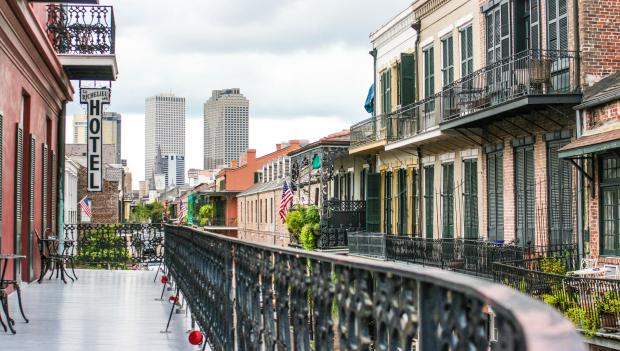
Birthplace of Jazz:
Credited with being the birthplace of jazz, New Orleans is all too often overlooked for its contributions to the blues. New Orleans Blues, a variation on Cajun-based Louisiana blues and upbeat New Orleans jazz, developed in the 1940s. This conflux of Mississippi Delta Blues and Caribbean percussion, with the heavy use of the piano and saxophone thrown in, created a dynamic sound that can be heard in the city today. Throw a stone in the Big Easy and it will likely land on a blues joint, or another club playing blue’s baby, jazz.
What to do:
The list of to-dos in New Orleans is a long one! Although you’ll have many choices, we recommend:
1. Walking Bourbon Street and stopping into local bars for live music, which can be found up and down the street at all hours.
2. Having dessert at the famous Cafe du Monde
3. Check out some of the many restaurants featuring local Louisiana and Cajun cuisine
Where to Stay:
Bayou Barataria RV Park
Bayou Segnet State Park
St. Bernard State Park
All three parks are safe and quiet, have plenty of campsites, and are about a 15-minute drive from downtown New Orleans.
That’s a Wrap!
By the end of your Blues road trip, no doubt your appreciation will have deepened, and you’ll also take away great memories of local culture, new sites, and history. We hope you enjoy your trip!
